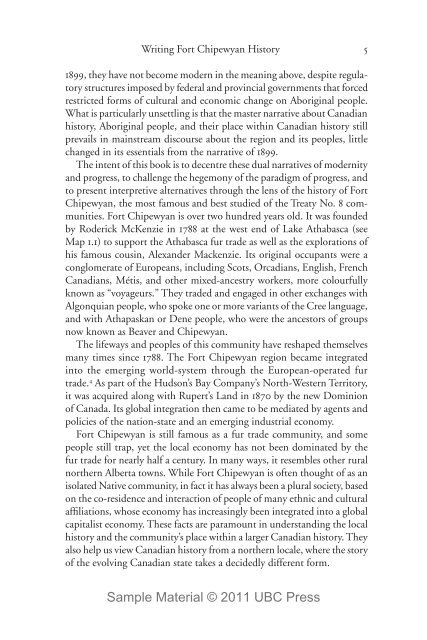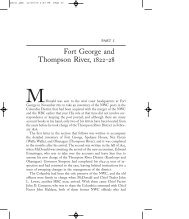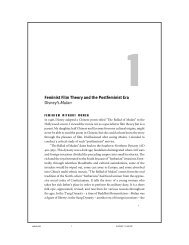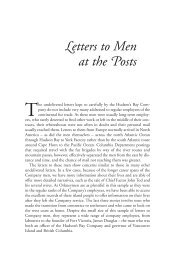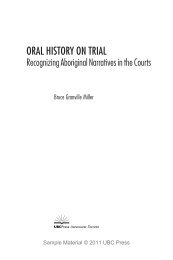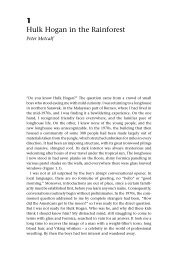Fort Chipewyan and the Shaping of Canadian History ... - UBC Press
Fort Chipewyan and the Shaping of Canadian History ... - UBC Press
Fort Chipewyan and the Shaping of Canadian History ... - UBC Press
You also want an ePaper? Increase the reach of your titles
YUMPU automatically turns print PDFs into web optimized ePapers that Google loves.
Writing <strong>Fort</strong> <strong>Chipewyan</strong> <strong>History</strong><br />
1899, <strong>the</strong>y have not become modern in <strong>the</strong> meaning above, despite regulatory<br />
structures imposed by federal <strong>and</strong> provincial governments that forced<br />
restricted forms <strong>of</strong> cultural <strong>and</strong> economic change on Aboriginal people.<br />
What is particularly unsettling is that <strong>the</strong> master narrative about <strong>Canadian</strong><br />
history, Aboriginal people, <strong>and</strong> <strong>the</strong>ir place within <strong>Canadian</strong> history still<br />
prevails in mainstream discourse about <strong>the</strong> region <strong>and</strong> its peoples, little<br />
changed in its essentials from <strong>the</strong> narrative <strong>of</strong> 1899.<br />
The intent <strong>of</strong> this book is to decentre <strong>the</strong>se dual narratives <strong>of</strong> modernity<br />
<strong>and</strong> progress, to challenge <strong>the</strong> hegemony <strong>of</strong> <strong>the</strong> paradigm <strong>of</strong> progress, <strong>and</strong><br />
to present interpretive alternatives through <strong>the</strong> lens <strong>of</strong> <strong>the</strong> history <strong>of</strong> <strong>Fort</strong><br />
<strong>Chipewyan</strong>, <strong>the</strong> most famous <strong>and</strong> best studied <strong>of</strong> <strong>the</strong> Treaty No. 8 communities.<br />
<strong>Fort</strong> <strong>Chipewyan</strong> is over two hundred years old. It was founded<br />
by Roderick McKenzie in 1788 at <strong>the</strong> west end <strong>of</strong> Lake Athabasca (see<br />
Map 1.1) to support <strong>the</strong> Athabasca fur trade as well as <strong>the</strong> explorations <strong>of</strong><br />
his famous cousin, Alex<strong>and</strong>er Mackenzie. Its original occupants were a<br />
conglomerate <strong>of</strong> Europeans, including Scots, Orcadians, English, French<br />
<strong>Canadian</strong>s, Métis, <strong>and</strong> o<strong>the</strong>r mixed-ancestry workers, more colourfully<br />
known as “voyageurs.” They traded <strong>and</strong> engaged in o<strong>the</strong>r exchanges with<br />
Algonquian people, who spoke one or more variants <strong>of</strong> <strong>the</strong> Cree language,<br />
<strong>and</strong> with Athapaskan or Dene people, who were <strong>the</strong> ancestors <strong>of</strong> groups<br />
now known as Beaver <strong>and</strong> <strong>Chipewyan</strong>.<br />
The lifeways <strong>and</strong> peoples <strong>of</strong> this community have reshaped <strong>the</strong>mselves<br />
many times since 1788. The <strong>Fort</strong> <strong>Chipewyan</strong> region became integrated<br />
into <strong>the</strong> emerging world-system through <strong>the</strong> European-operated fur<br />
trade. 4 As part <strong>of</strong> <strong>the</strong> Hudson’s Bay Company’s North-Western Territory,<br />
it was acquired along with Rupert’s L<strong>and</strong> in 1870 by <strong>the</strong> new Dominion<br />
<strong>of</strong> Canada. Its global integration <strong>the</strong>n came to be mediated by agents <strong>and</strong><br />
policies <strong>of</strong> <strong>the</strong> nation-state <strong>and</strong> an emerging industrial economy.<br />
<strong>Fort</strong> <strong>Chipewyan</strong> is still famous as a fur trade community, <strong>and</strong> some<br />
people still trap, yet <strong>the</strong> local economy has not been dominated by <strong>the</strong><br />
fur trade for nearly half a century. In many ways, it resembles o<strong>the</strong>r rural<br />
nor<strong>the</strong>rn Alberta towns. While <strong>Fort</strong> <strong>Chipewyan</strong> is <strong>of</strong>ten thought <strong>of</strong> as an<br />
isolated Native community, in fact it has always been a plural society, based<br />
on <strong>the</strong> co-residence <strong>and</strong> interaction <strong>of</strong> people <strong>of</strong> many ethnic <strong>and</strong> cultural<br />
affiliations, whose economy has increasingly been integrated into a global<br />
capitalist economy. These facts are paramount in underst<strong>and</strong>ing <strong>the</strong> local<br />
history <strong>and</strong> <strong>the</strong> community’s place within a larger <strong>Canadian</strong> history. They<br />
also help us view <strong>Canadian</strong> history from a nor<strong>the</strong>rn locale, where <strong>the</strong> story<br />
<strong>of</strong> <strong>the</strong> evolving <strong>Canadian</strong> state takes a decidedly different form.<br />
Sample Material © 2011 <strong>UBC</strong> <strong>Press</strong><br />
5


